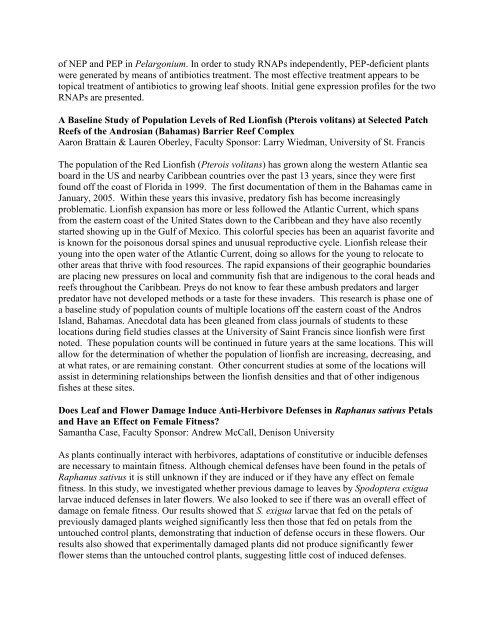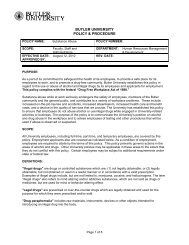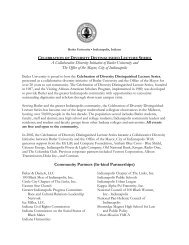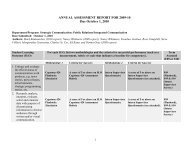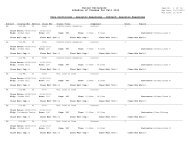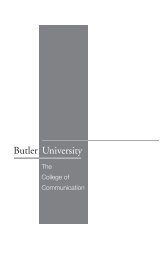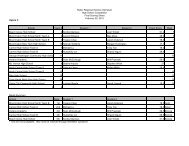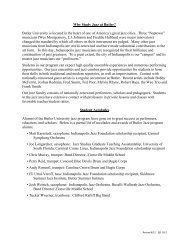Anthropology - Butler University
Anthropology - Butler University
Anthropology - Butler University
You also want an ePaper? Increase the reach of your titles
YUMPU automatically turns print PDFs into web optimized ePapers that Google loves.
of NEP and PEP in Pelargonium. In order to study RNAPs independently, PEP-deficient plants<br />
were generated by means of antibiotics treatment. The most effective treatment appears to be<br />
topical treatment of antibiotics to growing leaf shoots. Initial gene expression profiles for the two<br />
RNAPs are presented.<br />
A Baseline Study of Population Levels of Red Lionfish (Pterois volitans) at Selected Patch<br />
Reefs of the Androsian (Bahamas) Barrier Reef Complex<br />
Aaron Brattain & Lauren Oberley, Faculty Sponsor: Larry Wiedman, <strong>University</strong> of St. Francis<br />
The population of the Red Lionfish (Pterois volitans) has grown along the western Atlantic sea<br />
board in the US and nearby Caribbean countries over the past 13 years, since they were first<br />
found off the coast of Florida in 1999. The first documentation of them in the Bahamas came in<br />
January, 2005. Within these years this invasive, predatory fish has become increasingly<br />
problematic. Lionfish expansion has more or less followed the Atlantic Current, which spans<br />
from the eastern coast of the United States down to the Caribbean and they have also recently<br />
started showing up in the Gulf of Mexico. This colorful species has been an aquarist favorite and<br />
is known for the poisonous dorsal spines and unusual reproductive cycle. Lionfish release their<br />
young into the open water of the Atlantic Current, doing so allows for the young to relocate to<br />
other areas that thrive with food resources. The rapid expansions of their geographic boundaries<br />
are placing new pressures on local and community fish that are indigenous to the coral heads and<br />
reefs throughout the Caribbean. Preys do not know to fear these ambush predators and larger<br />
predator have not developed methods or a taste for these invaders. This research is phase one of<br />
a baseline study of population counts of multiple locations off the eastern coast of the Andros<br />
Island, Bahamas. Anecdotal data has been gleaned from class journals of students to these<br />
locations during field studies classes at the <strong>University</strong> of Saint Francis since lionfish were first<br />
noted. These population counts will be continued in future years at the same locations. This will<br />
allow for the determination of whether the population of lionfish are increasing, decreasing, and<br />
at what rates, or are remaining constant. Other concurrent studies at some of the locations will<br />
assist in determining relationships between the lionfish densities and that of other indigenous<br />
fishes at these sites.<br />
Does Leaf and Flower Damage Induce Anti-Herbivore Defenses in Raphanus sativus Petals<br />
and Have an Effect on Female Fitness?<br />
Samantha Case, Faculty Sponsor: Andrew McCall, Denison <strong>University</strong><br />
As plants continually interact with herbivores, adaptations of constitutive or inducible defenses<br />
are necessary to maintain fitness. Although chemical defenses have been found in the petals of<br />
Raphanus sativus it is still unknown if they are induced or if they have any effect on female<br />
fitness. In this study, we investigated whether previous damage to leaves by Spodoptera exigua<br />
larvae induced defenses in later flowers. We also looked to see if there was an overall effect of<br />
damage on female fitness. Our results showed that S. exigua larvae that fed on the petals of<br />
previously damaged plants weighed significantly less then those that fed on petals from the<br />
untouched control plants, demonstrating that induction of defense occurs in these flowers. Our<br />
results also showed that experimentally damaged plants did not produce significantly fewer<br />
flower stems than the untouched control plants, suggesting little cost of induced defenses.


